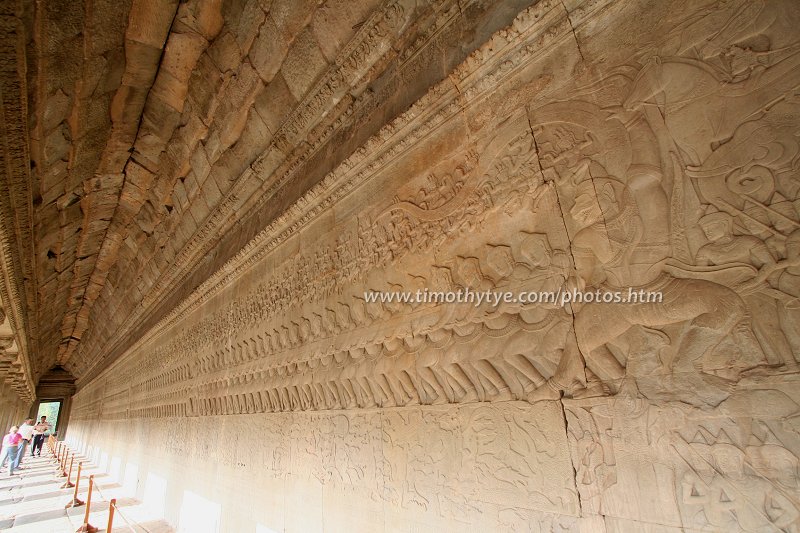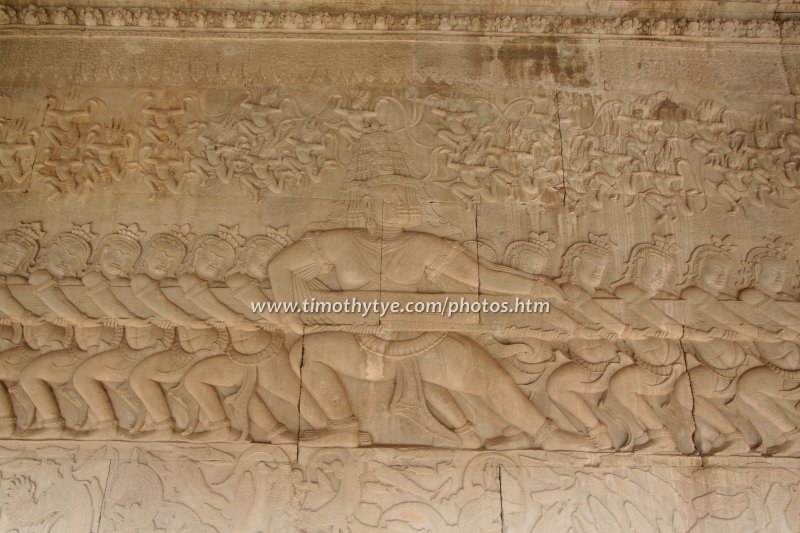 Churning the Ocean of Milk, Angkor Wat (26 February, 2006)
Churning the Ocean of Milk, Angkor Wat (26 February, 2006)
Churning the Ocean of Milk is the most famous and spectacular bas-relief gallery at Angkor Wat. It describes the Hindu creation myth from Bhagavata-Purana and is spectacularly depicted on one 49-meter panel. In Churning the Ocean of Milk, a rare cooperation came about between the devas (gods) and the demons (asuras) in pulling alternately on the giant naga Vasuki which is coiled around Mount Mandara. The purpose is to rotate the mountain to churn the cosmic Ocean of Milk to produce amrita, the elixir of immortality.
According to the Bhagavata-Purana, as soon as the amrita was produced, the devas took possession of it, and broke their promise to the asura to give them half, who then tried to steal it from the devas.
 Ravana joining in the Churning of the Ocean of Milk, Angkor Wat (26 February, 2006)
Ravana joining in the Churning of the Ocean of Milk, Angkor Wat (26 February, 2006)
On this gallery, we see the scene of the actual churning in the bas-relief. Walking from left to right again, we view in the first 5 meters the army of the asuras assembled with their horses and elephants. Then the churning scene starts. First we see Ravana, the giant multi-headed asura, holding the five heads of Vasuki, the giant naga (serpent or dragon). After that we see 92 identical asuras pulling in unison on the naga. On the lower tier we see marine creatures representing the Ocean of Milk. They are caught by the turbulence of the churning.
As we reach the centre of the panel, we see that these animals - fish, crocodile, turtle - are sliced into pieces because the churning is so violent. Mount Mandara is column-like, almost hidden behind the four-armed Vishnu who is directing the operations. Below Vishnu is his avatar (celestial vehicle), the turtle Kurma, who is supporting the mountain from sinking into the ocean. Above Vishnu we see Indra flying to keep the mountain steady. The churning created celestial nymphs, the apsaras, flying in two directions above.
 Vishnu directing the Churning of the Ocean of Milk, Angkor Wat (26 February, 2006)
Vishnu directing the Churning of the Ocean of Milk, Angkor Wat (26 February, 2006)
As we continue walking to the right, we see the row of devas pulling Vasuki. There are 88 of them, and finishing the scene we see the great monkey god, Hanuman, holding Vasuki's tail. Please note that in the original Hindu Bhagavata-Purana, there are neither Hanuman nor Ravana in the story. Somehow the Khmers have made some improvisation by adding these Ramayana characters into the Vedic legend.
 Latest updates on Penang Travel Tips
Latest updates on Penang Travel Tips
 Map of Roads in Penang
Map of Roads in Penang
Looking for information on Penang? Use this Map of Roads in Penang to zoom in on information about Penang, brought to you road by road.
Copyright © 2003-2025 Timothy Tye. All Rights Reserved.

 Go Back
Go Back